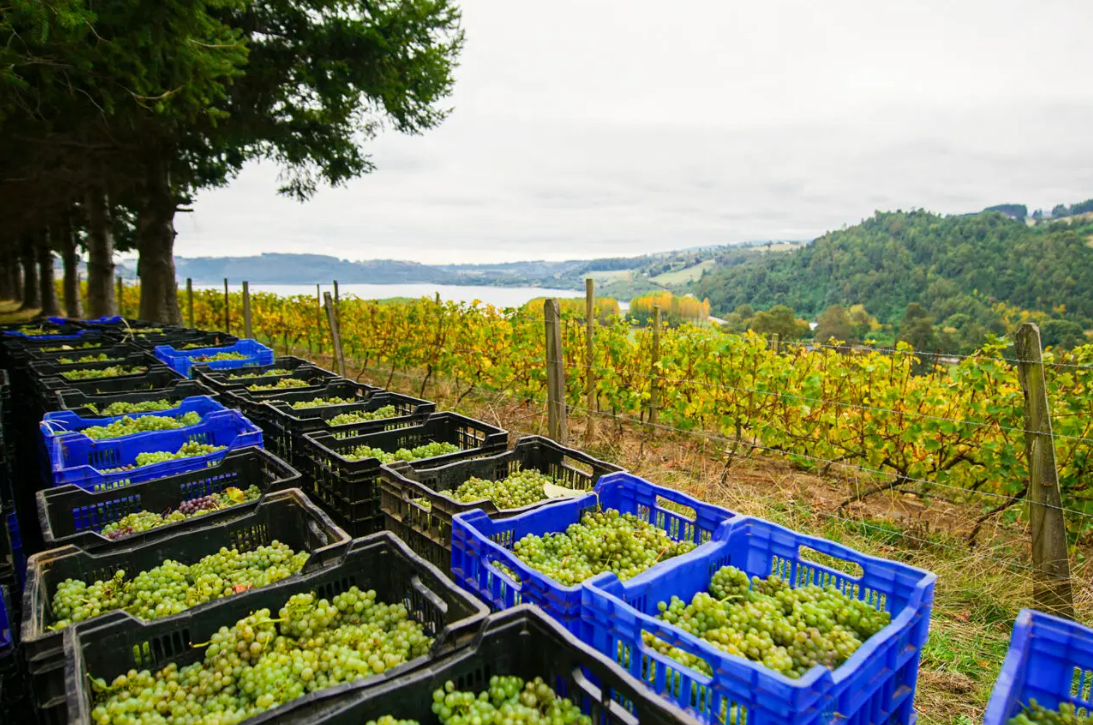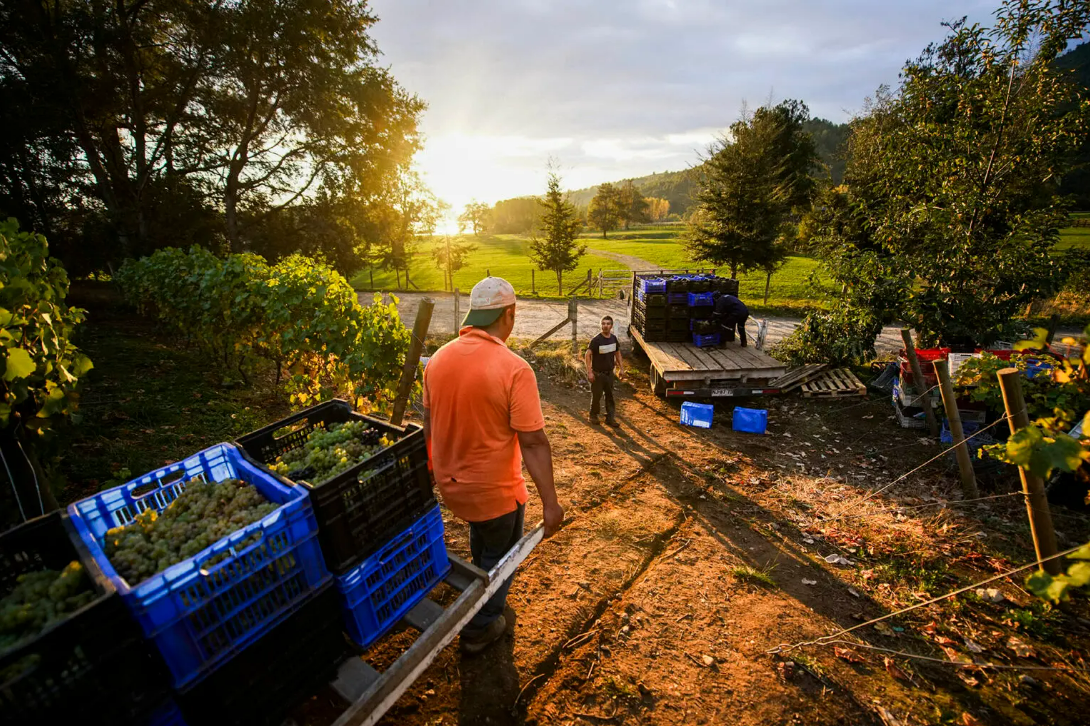The Volcanic Vines of Chile - Wine Enthusiast
Link to original article
Chile boasts the highest number of active volcanos among all South American countries. In fact, most of its main winegrowing regions feature soils composed of volcanic material originating from eruptions that occurred millions of years ago.
The country is narrow, defined by two distinct geological features—the Coastal and Andes mountain ranges that both run from north to south along the western and eastern edges, respectively. Their origin and that of the many volcanos that exist in Chile is due to the subduction of the denser Nazca Plate underneath the South American Plate.
“As a result, the Coastal Cordillera rose,” explains Chilean geologist Eder González. “The Nazca plate continues subducting, making magma and gas that form and feed the volcanos of the Andes.”
The movement of these tectonic plates is also the cause of many earthquakes. The world’s largest earthquake ever recorded, with a magnitude of 9.5, happened in Valdivia, southern Chile, in 1960.
In 2023, Chile’s National Geology and Mining Service ranked 14 out of 87 active volcanos as high-risk. However, when it comes to volcanic wine regions in the world, Chile is not commonly recognized or mentioned. The reason for this is perhaps that the soils associated with volcanic wine regions, such as Etna or the Canary Islands, are not commonly found in the vineyards of the popular Maipo, Colchagua or Casablanca valleys, but rather in selected places along the lesser-known southern and austral regions.
“When people think about volcanic soils, they often associate them with basalt and pome rocks,” says González. “While these soils do exist in Chile, they are mainly found in high altitudes in the Andes Mountains. Due to factors such as low temperatures and altitude, these areas are not well-suited for viticulture. But there are small wine regions that are currently developing and have this kind of soil.”
HARVEST OVERLOOKING LAGO RANCO / IMAGE COURTESY OF ALFREDO ESCOBAR FOR CASA SILVA
Itata: Basaltic and Granitic Soil
The Itata Valley is 269 miles south of Chile’s capital, Santiago. It’s a place that is experiencing a wine renaissance, thanks to its dry-farmed old vines of País and Cinsault.
País, also known as Mission in the U.S., was brought to the Americas by the Spaniards. It is one of the most planted red grape varieties in Chile, and in the past, was primarily used for simple table wines. However, winemakers are now determined to make fine wines that usually display a fresh, fruity and sometimes savory profile that differs from those of the warmer Central Valley.
The soil in Itata is heterogeneous, with many vineyards planted over granite. Granite is igneous in origin but not volcanic, meaning that it is formed from magma that cooled down slowly underground, but was not ejected from a volcanic eruption.
According to soil expert and winemaker Pedro Parra, there are approximately 741 acres of vines that grow over basaltic soil in Itata. Basalt can also be found in places such as Etna and the Canary Islands.
“The river transported the basaltic rocks from the Andes Mountain range to the center and coastal regions of Itata,” says Parra, who believes that basalt in its rocky-sandy stage is more beneficial for viticulture compared to when it’s in its decomposed clay form.
The terraces formed by the Itata river vary in sand and silt content. Basaltic sandy soil with a low percentage of silt has good water retention. With the region’s abundant rainfalls, vigorous varieties may struggle to produce quality grapes—but old País vines thrive here.
Parra’s Soulpit País, a lively red with a smoky, savory fruit flavor, is sourced from the banks of the river in the town of Ñipas. “Blind tasted, well-made País wines from old vines can be mistaken for wines from Etna or Tenerife,” says Parra. “They have the same ‘mineral’ character, with finely grained tannins and complexity.”
Malleco: Trumao Soil
Located near the Lonquimay Volcano, which erupted as recently as 1990, Malleco Valley has trumao soil, which is formed by volcanic ashes. After deposition some of this material was carried to other places in the region by the rivers.
This is a relatively new region for viticulture: Pioneer planter Viña Aquitania established the first vineyards in 1993. Since then, other wineries such as Morandé, Vinos Baettig and Clos des Fous have also started cultivating cool-climate white and red grape varieties.
Bodega Volcanes is, as its name implies, a winery on a mission to highlight the unique characteristics of Chile’s diverse volcanic soils.
“Sixty percent of the vines in Chile grow over volcanic soils,” says winemaker María del Pilar Díaz, who has led this project since its foundation in 2009.
Díaz explains that the composition of volcanic soils varies in diversity, ranging from rocky to sandy from north to south. “In Maipo you can find andesite and tuff rocks. As you go farther south to places like Maule, basalt sand can be found. In Malleco, sandy black trumao soil is common.”
Take a Deeper Dive: Understanding Volcanic Soils in Wine
In this region, vines grow small grapes, and the yields are low. The textured soil, mixed with clay, allows the roots to dig deep and provide excellent drainage. And with an annual rainfall of 47–60 inches, this is an important natural feature, as waterlogged roots can become an issue.
Beyond the soil factor, a cool climate allows the grapes to ripen slowly, giving these wines a balanced character. Díaz describes Chardonnays from Malleco as having a “mineral texture, chalky notes and delicate aromas of white peaches.”
HARVEST AT CASA SILVA / IMAGE COURTESY OF ALFREDO ESCOBAR FOR CASA SILVA
Osorno Valley: Pyroclastic
In 2006, Casa Silva ventured into the austral region of Chile and planted vines in Futrono. This decision pushed the boundaries of Chilean viticulture farther south. The vines grow on a hillside that overlooks Ranco Lake, near the Andes and the active Mocho-Choshuenco Volcano.
“Vines grow over volcanic soil that includes sedimentary and pyroclastic rocks and ashes,” says Juan Francisco Calderón, winemaker at Casa Silva. “This soil is deep and biologically active.”
Pyroclastic soil is made of ashes and fragmented pieces of solid materials that are ejected from volcanic eruptions. “The first layer is composed of loose and permeable materials, which then mix with clay,” notes Calderón.
Calderón admits that working in Osorno Valley has provided him with invaluable agricultural and enological knowledge. Since wine is not part of the cultural identity of the people who live in these areas, one of the challenges that he and his team faced was the lack of trained workers who could take care of the vines. Further, the soil and climate aren’t actually that well-suited for viticulture. The soil is acidic, restraining the availability of essential nutrients. Therefore, winemakers need to apply lime to the soil (a process referred to as “liming”) to make it less acidic and restore its pH balance.
Being in the austral region of Chile means experiencing high rainfall and cool weather. For this reason, early-ripening grape varieties such as Sauvignon Blanc, Chardonnay, Riesling and Pinot Noir are popular choices for viticulturists throughout the valley.
Due to the high humidity, fungal diseases are a threat. Therefore, Calderón explains, growers must remain vigilant and increase ventilation of the vine canopy to mitigate the risk of infection.
Despite the extreme climate, Calderón is confident that Osorno Valley has the perfect terroir for sparkling wine. Casa Silva is currently making bright white wines, aromatic Pinot Noir and a traditional method sparkling wine called I Fervor de Lago Ranco. The alcohol content in these wines ranges from 11.5–13.5%.
IMAGE COURTESY OF ALFREDO ESCOBAR FOR CASA SILVA
“We obtain terroir-focused wines, with organoleptic characteristics that set them apart from those of the Central region,” says Calderón. “White wines are more intense in color, especially Sauvignon Blanc, which presents golden hues. These are mineral fresh wines, with excellent and balanced acidity.”
Winemaking in Chile takes place in a wide range of climates and soils. Wines that come from soils with volcanic materials add value to the different expressions that can be found.
The diversity of the land in Itata, with basaltic and granitic soil, will continue to provide wines with energy and distinctive profiles. While in the austral Malleco and Osorno valleys more wineries are setting up their vineyards over volcanic soils, regardless of the extreme weather, the long distance from the country’s capital and the lack of trained workers that pose a challenge to the vignerons. The future is indeed bright, as these regions provide Chilean winemakers an opportunity to express a specific piece of Chilean terroir. “Year after year, volcanic soils give better wines that have a unique trait,” assures Calderón.



